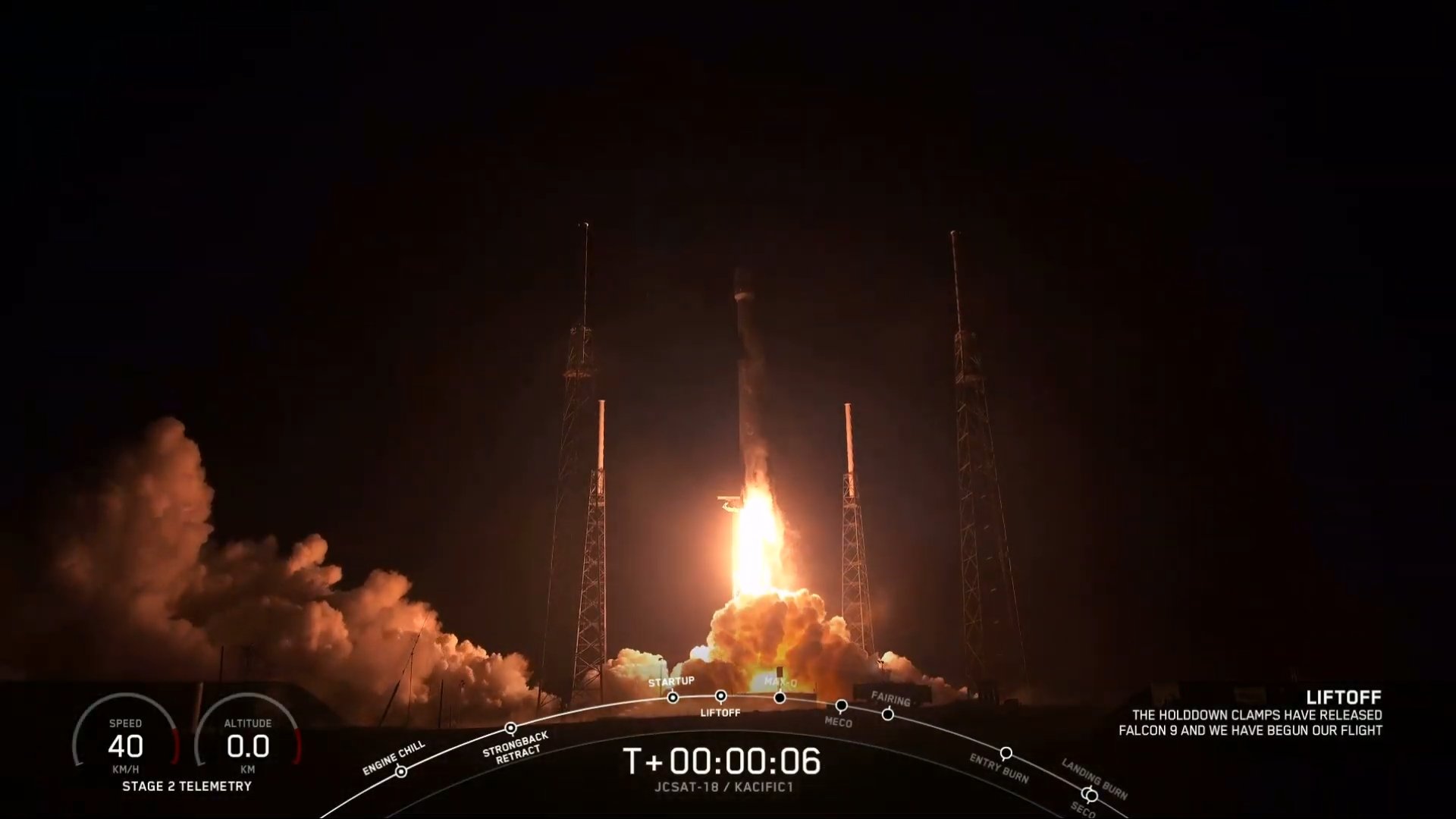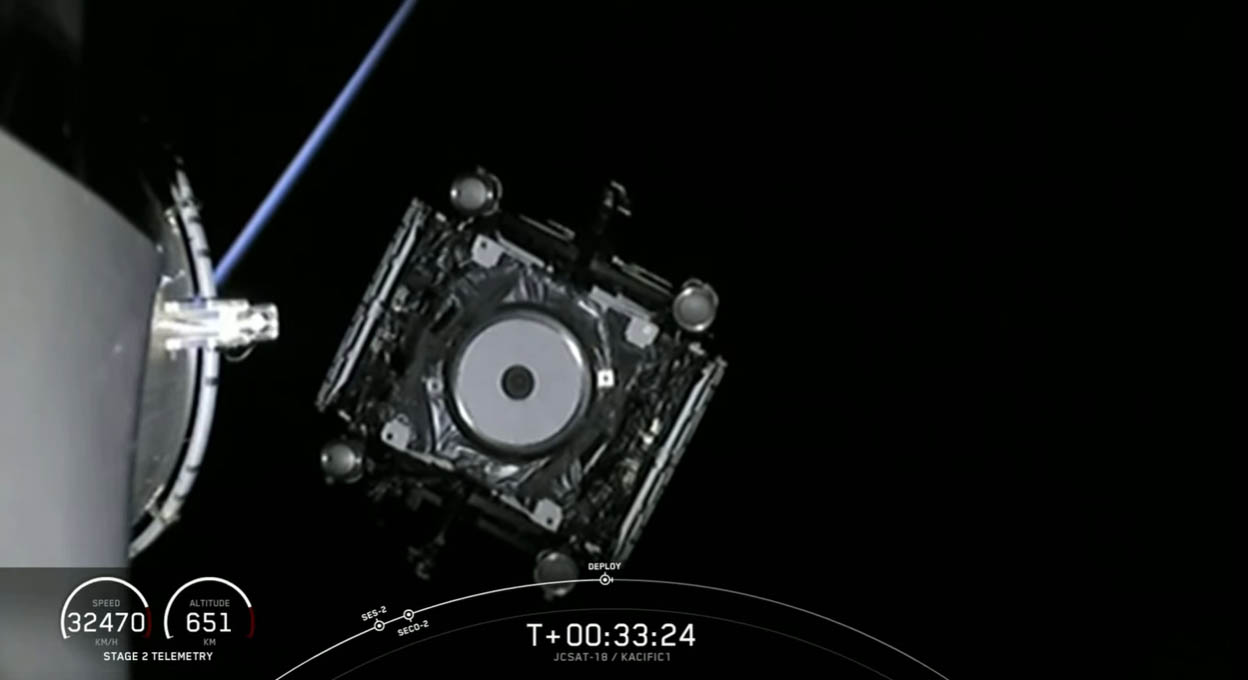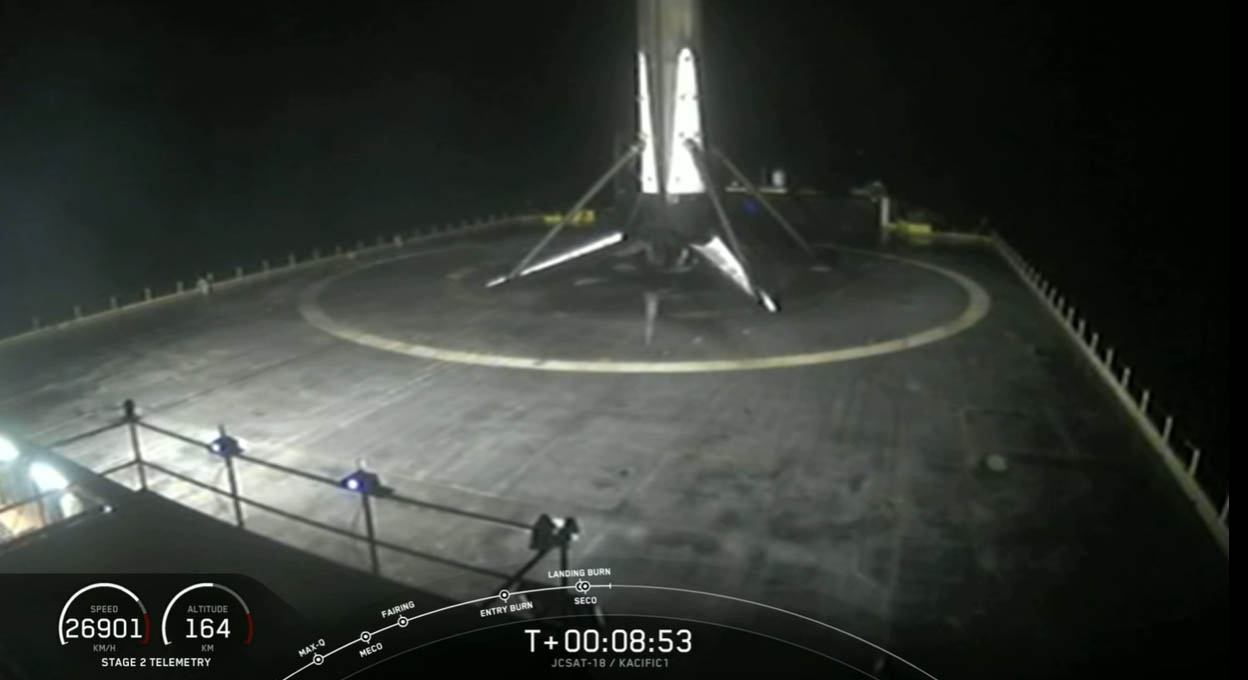SpaceX Falcon 9 Launches Heavyweight Satellite Into Orbit, Nails Rocket Landing
CAPE CANAVERAL, Fla. — SpaceX launched its 13th mission of the year Monday (Dec. 16) as a twice-flown Falcon 9 booster took to the skies for the third time carrying a satellite for a Singapore-based startup and Japanese broadband provider.
The Falcon 9 rocket lit up the skies over Florida's Space Coast as it carried its payload, a heavyweight communications satellite, into space from Space Launch Complex 40 here at Cape Canaveral Air Force Station. Liftoff occurred at 7:10 p.m. EST (0010 GMT)
Built by Boeing, the satellite will provide Ka-band internet coverage to 25 countries across the South Pacific. Dubbed JCSAT 18/Kacific-1, the 15,335-lb. (6,956 kilograms) satellite is equipped with 56 high-power beams that will provide mobile and broadband services from space. The satellite is a joint project between Singapore startup Kacific Broadband Satellites and Japanese operator Sky Perfect JSAT.
Video: SpaceX's Falcon 9 Stick its 3rd Landing After JCSAT-18/Kacific1 Launch

Services provided by the satellite will be especially beneficial to residents in remote provinces and villages across the South Pacific, especially healthcare institutions and schools. In a briefing before the launch today, Christian Patouraux, Kacific's CEO and founder, explained that many of the schools and hospitals throughout the region are remote and therefore could rely on the coverage this satellite will provide to ensure patients receive proper care and children have access to better education with more access to online resources.
Currently the region relies on Ku-band coverage that is cobbled together from free time on nearby satellites. But continuous coverage would dramatically improve the quality of life of those who call the region home — and it would be an added perk for tourists.

In one village alone, using the coverage currently available, medical staff have been able to connect with doctors in bigger cities and save lives, according to Patouraux.
Get the Space.com Newsletter
Breaking space news, the latest updates on rocket launches, skywatching events and more!
"Most people [across the South Pacific] have access to iPads and smartphones, but are just waiting for the technology — meaning internet service — to arrive to live better lives," Patouraux said.
Additionally, the broadband access will provide critical communications channels to a region which is often ravaged by natural disasters, such as earthquakes and tsunamis.
Related: See the Evolution of SpaceX's Rockets in Pictures
About half an hour after liftoff, the Falcon 9 rocket deposited the satellite into an elliptical transfer orbit, where its on-board engine will maneuver the satellite into a final geostationary orbit, more than 22,000 miles (35,000 km) above the equator. This orbit will allow the satellite to give constant coverage to the Asia-Pacific area.
The launch occurred just three days after SpaceX test fired its veteran Falcon 9 booster. The star of this launch, a sooty and scorched Falcon 9, previously lifted the CRS-17 and CRS-18 cargo resupply missions to the International Space Station earlier this year. Tonight's flight marked the 13th of the year for the California-based aerospace company, following a shiny new booster that delivered a fresh batch of supplies to the space station just 11 days earlier (on Dec. 5).
Approximately 8 minutes after launch, the rocket's first stage touched down on one of the company's two drone ships, Of Course I Still Love You, which was stationed in the Atlantic Ocean.

Earlier this month, Kacific announced it secured $160 million in new financing led by the Asian Development Bank (ADB) and GuarantCo, an infrastructure investment organization.
"The support from GuarantCo, ADB, and private investors will be pivotal in providing the long-term certainty that will allow Kacific to transition seamlessly into operational mode," Patouraux said in a company statement released Dec. 6.
Patouraux said that Kacific-1 aims to stream high-speed, reliable, low-cost broadbandto rural and suburban areas. The focus is to get the satellite's service up and running and if all goes well (and shareholders agree), there could eventually be a Kacific-2.
The follow-on would expand the coverage area to include parts of Asia and Africa.
- SpaceX Test-Fires Used Falcon 9 Rocket for Hefty Satellite Launch
- SpaceX Falcon 9 Rocket Will Launch Private Moon Lander in 2021
- SpaceX: Facts About Elon Musk's Private Spaceflight Company
Follow Amy Thompson on Twitter @astrogingersnap. Follow us on Twitter @Spacedotcom or Facebook.

Join our Space Forums to keep talking space on the latest missions, night sky and more! And if you have a news tip, correction or comment, let us know at: community@space.com.

Amy Thompson is a Florida-based space and science journalist, who joined Space.com as a contributing writer in 2015. She's passionate about all things space and is a huge science and science-fiction geek. Star Wars is her favorite fandom, with that sassy little droid, R2D2 being her favorite. She studied science at the University of Florida, earning a degree in microbiology. Her work has also been published in Newsweek, VICE, Smithsonian, and many more. Now she chases rockets, writing about launches, commercial space, space station science, and everything in between.









